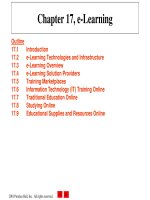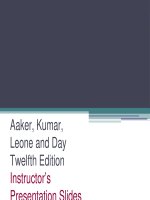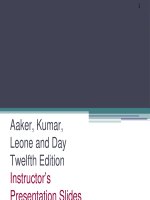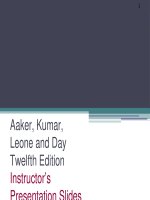Lecture Communication research: Asking questions, finding answers (4e) Chapter 17: Analyzing qualitative data
Bạn đang xem bản rút gọn của tài liệu. Xem và tải ngay bản đầy đủ của tài liệu tại đây (13.22 MB, 14 trang )
Chapter 1/
ANALYZING
QUALITATIVE DATA
AINA
NG
QUA
h
JAILF
* Analysis
+ Process of labeling and break down raw data
+ Brings order, structure, interpretation
+ Messy, ambiguous, time consuming
* Begins after first data collection
* Reflexive
* Inductive
EMIC READING OF DATA
Emergent
From participant’s point of
ETIC READING OF DATA
Interpreting data as related
to theories
view
More conceptual
In context data were
Without regard to context
collected
Insider, inductive, and
bottom-up
Outsider, deductive, topdown
* Sorting through a great deal of data is difficult
+ Requires careful choice of analytical method
* Multiple plausible interpretations will be
present
* The research question may have changed
* Must remain true to participants’ meanings
MOVING FROM RAW DATA TO INTERPRETATION
EE
Interpretation
Process of labeling and
breaking down raw data
to find patterns, themes,
concepts, and
propositions
ANALYTICAL MEMO
* Captures your first impressions of and reflections on
data
* Researcher writes memos
to him or herself
* Not part of the data
* First attempt at analyzing
+ Suggests avenues for additional collection or analytical
schemes
* Researcher's not participants evaluation
DIAGRAMMING DATA
* Place data Into tables, diagrams, or graphs
+ Helps see relationships
* Organize by
* Case
+ Subject
+ Theme
+ Event
* Reduces data into manageable size
* Category
+ Set of similar excerpts, examples, or themes
+ Existing or emergent
* Develop tentative labels
* Categories and labels will become
clearer over time
* Return to research questions
GROUNDED THEORY
Develop theory by
x
steps
examining relationships
between data and
-
Become familiar with data by
reading and re-reading
categories
-
Code data
Use constant-comparative
*
Develop initial, inductive
method to develop
categories
categories relative to each
*
Revise categories
other
-
Write memos to explore ideas
Categories can change and
new categories added
-
Iterative approach for coding
Two types of coding
OPEN CODING
AXIAL CODING
Subsequent passes through
data
Linking categories In
meaningful ways
Categories are collapsed or
relabeled
Theoretically saturated when
categories are stable
THEORETICAL SATURATION OCCURS
WHEN ALL DATA ARE CODED INTO A CATEGORY
ASSESSING RESULTS FROM GROUNDED THEORY
1.
Do the data merit your claims?
2.
Are new insights generated?
3.
Do categories reflect the essence of what was
studied?
4.
Are the findings useful in everyday life and
future research’?
THEMATIC ANALYSIS
* Theme = conceptualization of interaction,
relationship, event
* Three criteria
+ Recurrence
+ Repetition
+ Forcefulness
* Making sense or giving meaning to patterns,
themes, concepts, and propositions
* Translating categories into meaningful whole
* Memo writing Is intermediate step before
writing report
+ Can be used as basis of drafting the report
* Use participant quotes as evidence that the analysis
and interpretation are plausible
+ Provide enough quotes to demonstrate breadth and depth
of category or theme
* Credibility
+ Are findings believable’?
+ Are findings agreeable to participants?
* Triangulation









